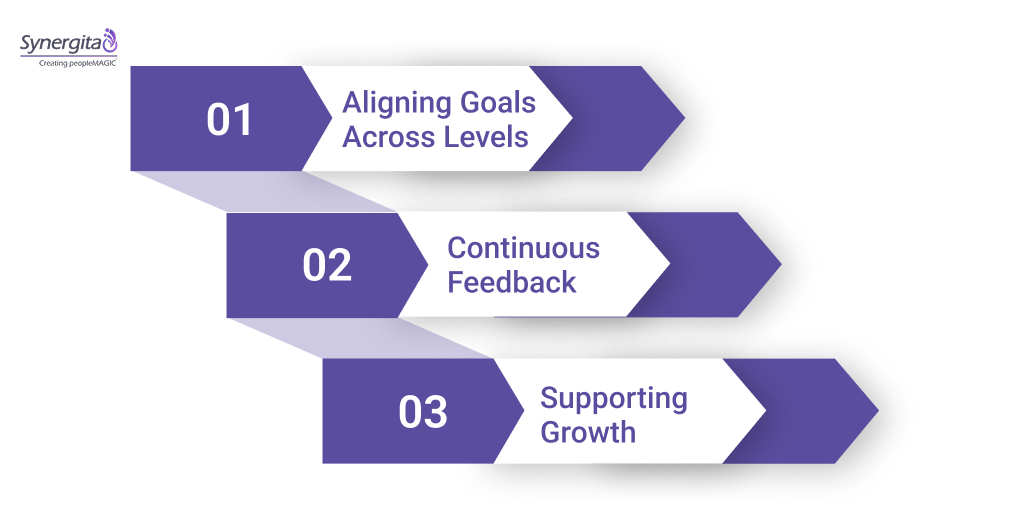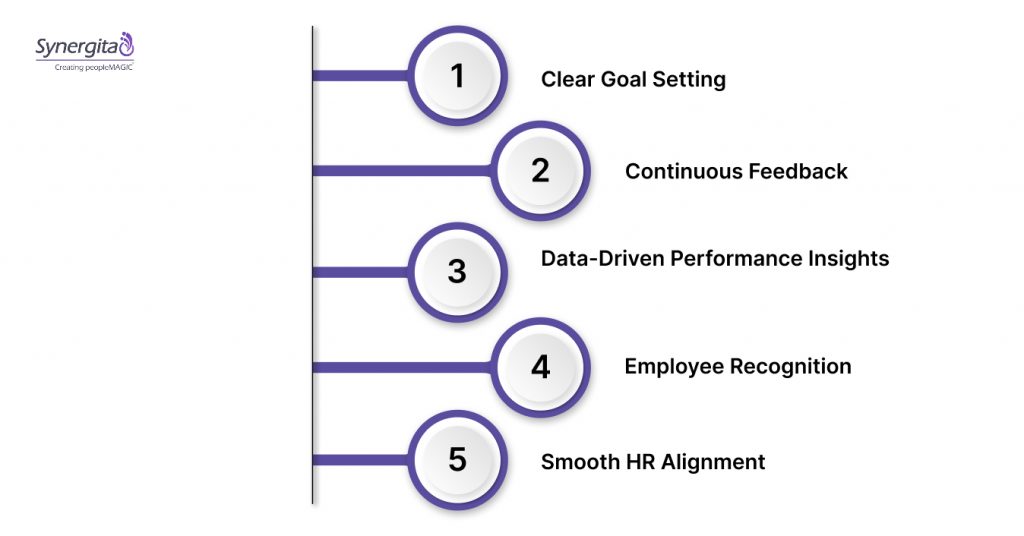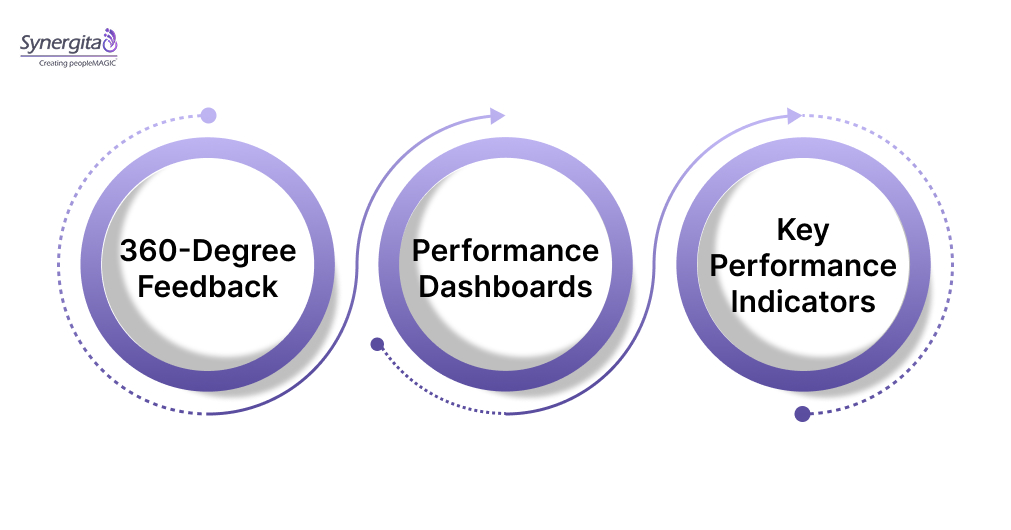You know the feeling, sitting through another performance review cycle and wondering if it’s really making a difference. Even when goals are set and feedback is given, engagement often feels flat. In fact, a 2024 Gallup study shows only 21% of employees globally feel truly engaged at work.
That’s a problem you’ve probably seen firsthand: disengaged employees, unclear priorities, and managers spending more time on forms than on coaching. The purpose of performance management isn’t just to tick boxes; it’s about creating a system where goals, feedback, and growth connect seamlessly, so employees feel seen and managers can guide effectively.
This blog highlights how performance management keeps teams motivated, aligned, and moving forward with practical, actionable strategies.
Key Takeaways:
- Alignment: Effective performance management connects goals across individuals, teams, and the organization.
- Engagement: It boosts participation, continuous feedback, and focused skill growth.
- Core Elements: OKRs, regular feedback, data-driven insights, recognition, and HR system integration.
- Key Metrics: Goal achievement, work quality, productivity, retention of top talent, manager effectiveness, employee engagement, and revenue per employee.
- Measurement Tools: 360-degree feedback, performance dashboards, and KPIs.
- Common Challenges: Unclear goals, infrequent feedback, bias, low engagement, managerial gaps, difficulty linking performance to outcomes, and resistance to change.
- Solutions: SMART goals, continuous feedback, data-driven platforms, coaching, and early stakeholder involvement.
- Tools Advantage: Platforms like Synergita make alignment, real-time tracking, and ongoing performance improvement easier.
The Strategic Purpose and Key Benefits
At its heart, performance management isn’t just about evaluating your team; it’s about giving them clarity and direction. It creates a framework where roles, expectations, and progress are visible, helping everyone focus on the outcomes that really matter.
For example, imagine you’re leading a product development team launching a new feature. By setting clear milestones, tracking progress regularly, and providing actionable feedback, you ensure that each person’s work drives the project forward. This keeps the team aligned and avoids wasted effort.
The strategic purpose of performance management includes:

- Aligning Goals Across Levels: Connecting individual and team objectives to broader organizational priorities.
- Driving Continuous Feedback: Encouraging real-time conversations to address challenges and reinforce progress.
- Supporting Growth and Development: Identifying skill gaps and enabling targeted learning opportunities.
Key benefits of this approach include:

- Sharper Focus on Outcomes – Clear goals help teams prioritize high-impact work; e.g., sales reps track monthly targets to focus on closing high-value deals.
- Stronger Engagement – Employees see how their work affects company goals; e.g., support teams monitor resolution times to understand their impact on retention.
- Smarter Talent Decisions – Performance data guides promotions, training, and resource allocation; e.g., marketing managers identify high performers for leadership growth.
- Continuous Growth and Development – Ongoing feedback highlights skills to improve; e.g., engineers use insights to plan training in new technologies.
When these benefits work together, platforms like Synergita help make progress, recognition, and development visible and actionable, turning performance management into a seamless, continuous part of daily work.
With the benefits clear, the next step is to uncover the elements that actually make performance management work on a day-to-day basis.
Essential Elements of Effective Performance Management

Effective performance management isn’t just about annual reviews; it’s an ongoing process that keeps your team aligned, growing, and accountable. Based on industry best practices, here are the core components that make performance management work for you and your team:
1. Clear Goal Setting and Alignment
Setting measurable objectives ensures employees know what to focus on. OKRs (Objectives and Key Results) are widely used to connect individual and team goals with company priorities.
Example: A customer support team might have an objective to “Increase customer satisfaction,” with key results like “Reduce average response time to 6 hours” and “Achieve 90% positive feedback on support tickets.” Tools like Synergita help track these OKRs and display progress visually for all stakeholders.
2. Continuous Feedback and Coaching
Employees benefit from regular guidance rather than waiting for yearly appraisals. Continuous feedback highlights strengths and areas for improvement, supporting development in real time.
Example: Managers can collect peer and supervisor feedback on a quarterly project using a 360° review feature, helping employees adjust their performance promptly.
3. Data-Driven Performance Insights
Analyzing performance metrics helps HR identify patterns, recognize high performers, and detect risks early.
Example: An HR analyst reviews productivity dashboards showing project completion rates, quality scores, and attendance trends to spot bottlenecks or high-achieving employees.
4. Employee Recognition and Rewards
Acknowledging accomplishments strengthens engagement and morale. Recognition tied to meaningful results motivates employees to maintain high standards.
Example: A sales team celebrates quarterly achievements by publicly highlighting top performers and sharing success stories in team meetings.
5. Alignment with HR Systems for Smooth Workflows
Linking performance management with core HR processes ensures consistency and avoids duplication.
Example: Training completions, promotion updates, and performance ratings are recorded in the central HR system, ensuring that managers and payroll have accurate, synchronized information.
Once the essential elements are in place, the next step is understanding how all these efforts translate into tangible results for teams and the organization.
Measuring the Impact of Performance Management
Think about it: it’s not just about whether people are hitting targets or filling out reviews. The real value of performance management becomes evident in how engaged your team feels, where productivity gets stuck, and how leadership choices impact the entire group.
Watching the right metrics lets you see not just output, but how work quality, retention, and growth really play out across your organization.
Key Metrics to Keep an Eye On:
- Goal Achievement Rate – Percentage of individual or team goals completed on time, highlighting alignment with business objectives and spotting productivity gaps.
- Quality of Work – Accuracy, consistency, and adherence to standards, tracked via audits or error rates, ensuring productivity doesn’t compromise output.
- Productivity & Utilization – Volume of tasks completed or revenue-generating hours logged per employee, balancing output with effectiveness to identify bottlenecks.
- Performance Review & Continuous Feedback – Frequency of completed reviews and informal feedback adoption, reflecting commitment to ongoing development and agile correction.
- High Performer Retention & Internal Mobility – Retention rate of top talent and time since last promotion, indicating workforce stability and growth opportunities.
- Manager Effectiveness – Leadership quality is measured through team engagement, feedback frequency, and turnover, which collectively impact productivity and morale.
- Employee Engagement Metrics – Real-time pulse surveys, sentiment analysis, and behavioral analytics to detect disengagement early and improve retention.
- Revenue per Employee – Links workforce performance to financial outcomes, tracking efficiency and growth potential over time.
Tools and Approaches for Measuring Impact

Effective performance measurement relies on tools that turn feedback and data into actionable insights. Here are the most important:
- 360-Degree Feedback: Gathers performance data from an employee’s peers, subordinates, and supervisors for a comprehensive view of performance and development.
- Performance Dashboards: Provide real-time visibility into team and individual performance, enabling proactive decision-making and effective collaboration.
- Key Performance Indicators (KPIs): Tracks quantifiable metrics like sales, project completion, and customer satisfaction to measure performance outcomes.
Even with strong measurement in place, teams often run into practical challenges; understanding them helps turn data into real impact.
Challenges and Solutions in Performance Management
Even well-established HR teams encounter obstacles in keeping performance management effective. Fossil Group, for instance, relied on paper-based reviews that were slow and lacked actionable feedback. This caused delays in recognizing high performers and addressing skill gaps.
By moving to a digital platform with continuous feedback and goal alignment, they improved engagement, accelerated development, and saw clearer performance outcomes.
The following table outlines common challenges and practical ways organizations address them.
| Challenges | Solutions / Best Practices |
|---|---|
| Unclear or unmeasurable goals | Set SMART goals and use data-driven platforms |
| Infrequent feedback | Implement continuous feedback and agile check-ins |
| Bias in evaluations | Combine 360° feedback with objective metrics; train managers |
| Low engagement | Track sentiment in real-time and address issues quickly |
| Managerial skill gaps | Offer coaching programs and use performance dashboards |
| Linking performance to outcomes | Connect performance data with revenue and operational metrics |
| Resistance to change | Engage early, provide training, run pilot projects |
Conclusion
High-performing teams don’t just happen; they’re the result of a performance management approach that actively connects goals, feedback, and outcomes to real-world behavior. The key insight is seeing performance as a living system: when data, engagement, and development intersect, decisions become sharper and results more predictable.
Tools like Synergita help visualize and manage this ecosystem, making alignment and continuous improvement intuitive rather than manual. To experience how these connections play out day-to-day, a demo offers a clear, practical perspective.
FAQs
1. What is the real value of performance management beyond annual reviews?
It helps create continuous alignment between individual work and company priorities while identifying growth opportunities in real time.
2. How can performance management influence retention of top talent?
By tracking high performers, offering regular feedback, and connecting their goals to business outcomes, organizations can reduce turnover.
3. Which metrics give the clearest picture of team effectiveness?
Goal achievement rates, quality of work, productivity, and engagement scores reveal how well teams meet objectives and maintain standards.
4. How does 360-degree feedback improve employee development?
It collects perspectives from peers, managers, and subordinates to highlight strengths, blind spots, and actionable development areas.
5. What makes performance management systems truly effective for managers?
When dashboards, KPIs, and real-time feedback are combined, managers can guide teams with clarity and address issues before they escalate.


